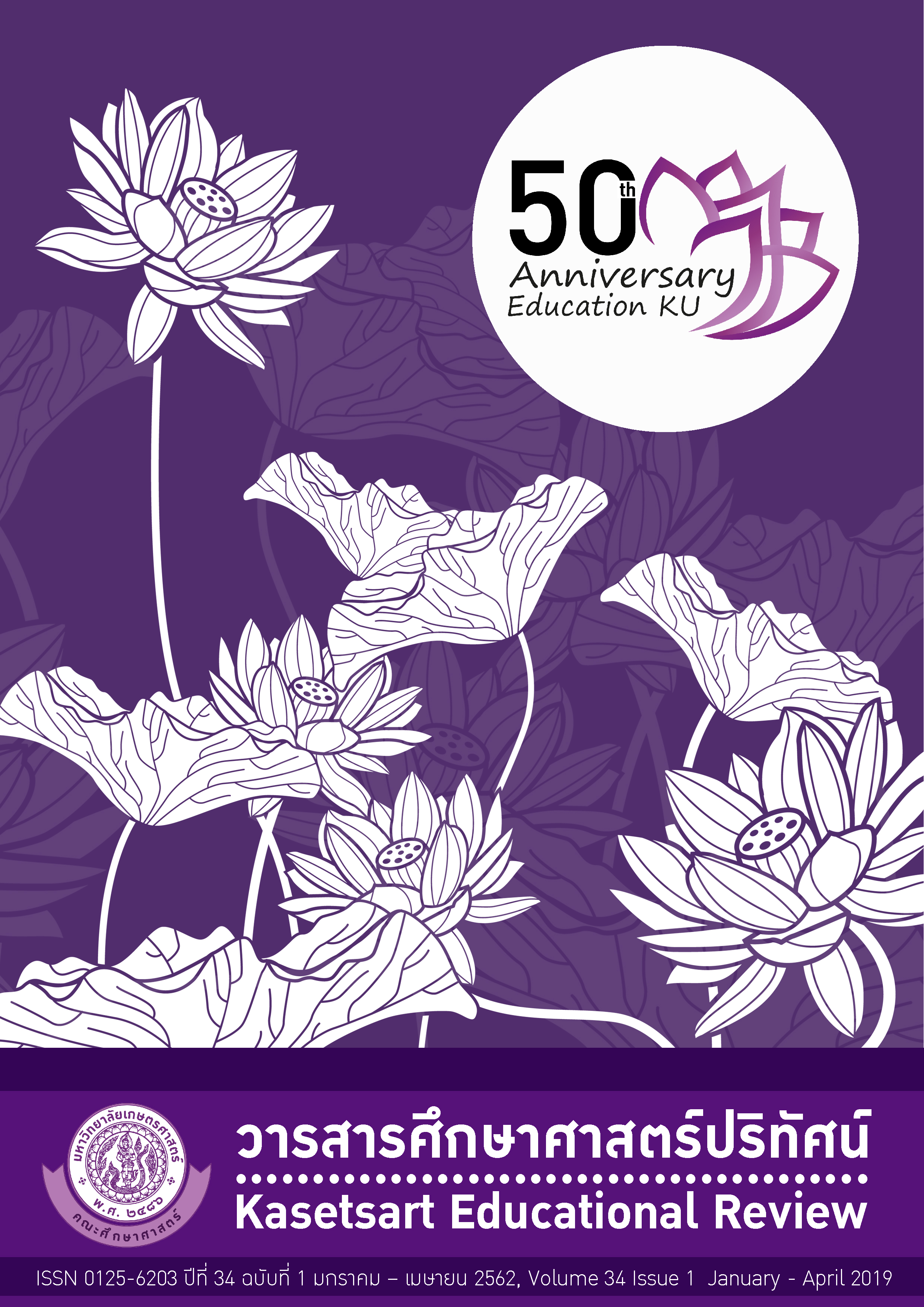Needs and Expectations for an ELT Master’s Program in Thailand: Voices from Pre- and In-Service Teachers
คำสำคัญ:
Needs Analysis, ELT, English Teaching and Learning, Master’s Program, Curriculum Development, Medium of Instruction, Pre-and In-service Teachersบทคัดย่อ
With the national and international policies on the qualifications required for Thai teachers of English to possess, a graduate degree program in English Language Teaching (ELT) could foster the mission and vision to develop the teaching and learning English at a school setting and the nation at large. Consequently, understanding the current trends and the factors that influence prospective students’ decision in choosing a program of study is an important aspect in the curriculum development of a graduate degree program in ELT. This study examined the key elements influencing the decision of students to study in the ELT master’s program at Ramkhamhaeng University, Thailand so that the university and the program committee would be able to use them in planning and developing the curriculum. Nine participants of this study were education administrators, experienced teachers, RU pre-service English teachers, and RU master graduates. An online questionnaire and interviews were used and implemented in the study. The results of the study show that the lecturers’ qualifications, tuition and fees, and weekend class schedules were the key factors for the prospective students to make a decision on the selection of a master’s degree program. In addition, the results show the needs and aspects that the participants have on the program as well as the ELT and other courses related to English language teaching that are in high demand. Some suggestions and implications for future research were also addressed.เอกสารอ้างอิง
Adipat, S. (2018). Task-Based Instruction with Integration of Technology for Pre-Service English Teachers. Kasetsart Educational Review, 33(2), 21-28. [in Thai]
Arifah, A. (2014). Study on the use of technology in ELT classroom: Teachers’ perspective. (M.A. Thesis, Department of English and Humanities, BRAC University, Dhaka, Bangladesh).
Arunsuksawang, T. & Sungrugsa, N. (2015). The factors that have an effect on ability of English usage following the learning skills in the 21st century of the Mattayom 6 students of schools in the Bangkok secondary educational area office 2 to support the entrance into the ASEAN Economic Community. Veridian E-Journal Humanities, Social Sciences and Arts Silpakorn University, 8(2), 493-505. [in Thai]
Baker, W. (2012). English as a lingua franca in Thailand: Characterizations and implications. Englishes in Practice, 1, 18-27.
Barbazette, J. (2006). Training needs assessments: Methods, tools and techniques. San Francisco, Calif: Pfeiffer.
Bordia, S., Wales, L., Pittam, J. & Gallois, C. (2006). Student expectations of TESOL programs: Student Student and teacher perspectives. Australian Review of Applied Linguistics, 29(1), 4.1-4.21. doi: 10.2104/aral0604.
Buehl, D. (2001). Classroom strategies for interactive learning (2nd ed.). Newark, DE: International Reading Association.
Crystal, D. (2003).English as a global language(2nd ed.). Cambridge:Cambridge University Press.
Darasawang, P. (2007). English language teaching and education in Thailand: A decade of change. In N. D. Prescott (Eds.), English in Southeast Asia: Varieties, literacies and literatures (pp. 187-204). Cambridge Scholars Publishing.
Dhanasobhon, S. (2006). English language teaching dilemma in Thailand. Kasetsart Educational Review, 22(1), 53-59.
Fry, G. W. (2013). Thailand’s new language policy helps enhance cultural democracy. Retrieved from http://www.nationmultimedia.com/opinion/Thailands-new-languagepolicy-helps-enhance-cultur-30219853.html.
Gilakjani, A. P. (2014). A detailed analysis over some important issues towards using computer technology into the EFL classrooms. Universal Journal of Educational Research, 2(2), 146-153.
Graves, K. (2000). Designing language courses: A guide for teachers. Boston, MA: Heinle Cengage.
Hadla, Z. (2013). Student and teacher perceptions of native and non-native English speaking English - speaking teachers in Lebanese context. (Ed.D. Dissertation). University of Exeter, UK.
Hutchinson, M. (2013). Bridging the Gap: Preservice Teachers and Their Knowledge of Working with English Language Learners. TESOL Journal. 4.
Jupiter, H., Othman, I.W., Mohd, N., Yusoff, S. M. S., Awang, H. & Razak, R.A. (2017). Factors influencing international student’s decision in choosing study destination abroad. Labuan e-Journal of Muamalat and Society, 11, 86-97.
Kaur, A., Young, D. & Kirkpatrick, R. (2016). English Education Policy in Thailand: Why the Poor Results? In R. Kirkpatrick (Ed.). English Language Education Policy in Asia, Language Policy 11 (pp. 345-361). Switzerland: Springer International Publishing.
Ministry of Education of Thailand. (2006). National Qualifications Framework for Higher Education in Thailand: Implementation Handbook. Retrieved from http://www.mua.go.th/users/tqf-hed/news/FilesNews/FilesNews8/NQF-HEd.pdf. [in Thai]
Murray, G. (2009). Narrative inquiry. In J. Heigham& R.A. Croker (Eds). Qualitative Research inApplied Linguistics (pp.45–65). Houndmills: Palgrave Macmillan.
Nunan, D. (1988). The learner-centred curriculum. Cambridge: Cambridge University Press.
Office of the Higher Education Commission (OHEC). (2006). National Qualifications Framework for Higher Education in Thailand. Bangkok: OHEC.
Pattapong, K. (2015). Complex Interactions of Factors Underlying Thai EFL learners’ Willingness to Communicate in English. PASAA: Journal of Language Teaching and Learning in Thailand, 49, 105-136.
Paul, R. & Norbury, C. F. (2012). Language disorders from infancy through adolescence: Listening, speaking, reading, writing and communicating (4th ed.). St. Louis, Mo.: Elsevier.
Petruzzellis, L. & Romanazzi, S. (2010). Educational Value: How Students Choose University: Evidence from An Italian University. International Journal of Educational Management, 24(2), 139-158.
Saville-Troike, M. (2006). Introducing second language acquisition. Cambridge, UK: Cambridge University Press.
Teachers of English to Speakers of Other Languages (TESOL) International Association. (2009). TESOL Professional Teaching Standards. Retrieved from http://www.tesol.org/advance-the-field/standards/tesol-caep-standards-for-p-12-teacher-education-programs.
The ASEAN Charter. (2008). ASEAN Secretariat. Retrieved from http://asean.org/wp-content/uploads/images/archive/publications/ASEAN-Charter.pdf.
Waenthong, J. (1999). Make English learning fun and meaningful. Khonkaen Technical College Journal, 2(6), 54–55. [in Thai]
ดาวน์โหลด
เผยแพร่แล้ว
ฉบับ
ประเภทบทความ
สัญญาอนุญาต
บทความทุกบทความเป็นลิขสิทธิ์ของวารสารคณะศึกษาศาสตร์ มหาวิทยาลัยเกษตรศาสตร์ วิทยาเขตบางเขน
วารสารศึกษาศาสตร์ปริทัศน์ (Kasetsart Educational Review)






